Opinion
Oil Palm Elephant and the Blind Men
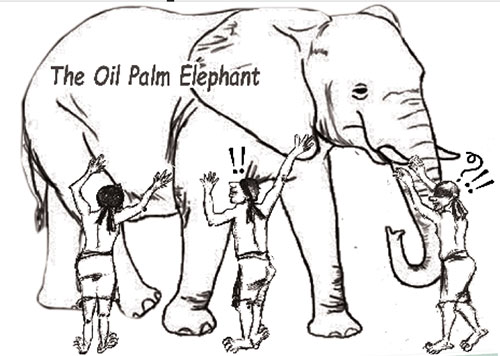
Various unsubstantiated utterances have been made by some on oil palm cultivation in Sri Lanka, without looking in depth into the subject. Little knowledge is a dangerous thing! A leading politician, in the south, some months ago, prior to the elections, went to the extent of felling a few oil palm trees along a stream bank, probably growing out of seeds dispersed by birds and animals from existing plantations around. He was, of course, seeking to impress villagers in the oil palm cultivating areas ,prior to the elections! Some villagers have been vociferously demanding the banning of the crop, claiming that it is drying up their water resources, although the available scientific evidence does not support their contention. Anyhow, they have now succeeded with the President banning the crop without an in- depth analysis of the issues at stake!
Interestingly, the Government Medical Officers’ Association, some days ago, conducted a seminar on coconut oil, but the unstated objective appeared to be to promote coconut oil and concurrently degrade palm oil! However, except for a few presentations, that of a historian and several Aurvedic specialists, the others failed to articulate effectively a factual comparison of the two crops and their oils.
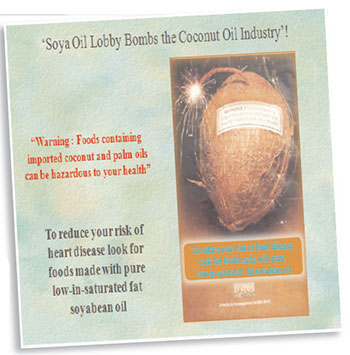 A lecturer of the Wayamba University ‘sang the usual song’ of oil palm cultivations excessively drying the soil and water bodies as against rubber, without supporting data. He should have conducted a comparative hydrological study of an exclusively oil palm cultivated area as against a nearby rubber only area to support his contention. The published comparative evapo-transpiration evidence of oil palm and rubber do not support his views. A biochemist (a retired professor) comparing the chemical composition of fatty acids in coconut and palm oil stated the virtues of coconut oil fats, but hardly anything about palm oil fats. It is a well known fact that coconut oil is a functional food , that means it has health benefits other than the nutritional. Its main health benefit is the high composition of the so called medium chain fatty acids, lauric, capric and caproic acids, which constitute nearly 63% of the total fatty acid content. Lauric and capric acids are reported to have anti-microbial properties. In fact lauric acid is also a component of mother’s milk and is reported to provide suckling babies immunity against harmful microbes. On the other hand, some coconut fats namely, lauric, myristic and palmetic acids comprising about 74% of the fatty acids in coconut oil are reported to elevate cholesterol. It is to be noted then that lauric acid is doing both good and bad! On the other hand, palm oil lacks the medium chain fatty acids, there being only a trace of lauric acid and accounts for about 46% cholesterol elevating saturated fats, nearly all of it being palmetic acid. Nevertheless, it has 39% oleic acid, a monounsaturated fat, and 9% lenoleic acid, an unsaturated fat both of which reduce total cholesterol. It is important to note that the monounsaturated fat, oleic acid, in palm oil, as also in avocado and cashew nuts, decrease only the (bad) LDL cholesterol but not the good (HDL) cholesterol. Palm kernel oil on the other hand, comprising less than 10% of the total oil content in the fruit, has a fatty acid composition, very comparable to coconut oil. On the whole, therefore, palm oil can be argued to be more heart friendly than coconut oil! Regrettably, the good professor should have explained all this to the participants of the meeting! However, it is now accepted that consumption of coconut oil in moderation does not elevate the risk of heart disease. The same applies to palm oil.
A lecturer of the Wayamba University ‘sang the usual song’ of oil palm cultivations excessively drying the soil and water bodies as against rubber, without supporting data. He should have conducted a comparative hydrological study of an exclusively oil palm cultivated area as against a nearby rubber only area to support his contention. The published comparative evapo-transpiration evidence of oil palm and rubber do not support his views. A biochemist (a retired professor) comparing the chemical composition of fatty acids in coconut and palm oil stated the virtues of coconut oil fats, but hardly anything about palm oil fats. It is a well known fact that coconut oil is a functional food , that means it has health benefits other than the nutritional. Its main health benefit is the high composition of the so called medium chain fatty acids, lauric, capric and caproic acids, which constitute nearly 63% of the total fatty acid content. Lauric and capric acids are reported to have anti-microbial properties. In fact lauric acid is also a component of mother’s milk and is reported to provide suckling babies immunity against harmful microbes. On the other hand, some coconut fats namely, lauric, myristic and palmetic acids comprising about 74% of the fatty acids in coconut oil are reported to elevate cholesterol. It is to be noted then that lauric acid is doing both good and bad! On the other hand, palm oil lacks the medium chain fatty acids, there being only a trace of lauric acid and accounts for about 46% cholesterol elevating saturated fats, nearly all of it being palmetic acid. Nevertheless, it has 39% oleic acid, a monounsaturated fat, and 9% lenoleic acid, an unsaturated fat both of which reduce total cholesterol. It is important to note that the monounsaturated fat, oleic acid, in palm oil, as also in avocado and cashew nuts, decrease only the (bad) LDL cholesterol but not the good (HDL) cholesterol. Palm kernel oil on the other hand, comprising less than 10% of the total oil content in the fruit, has a fatty acid composition, very comparable to coconut oil. On the whole, therefore, palm oil can be argued to be more heart friendly than coconut oil! Regrettably, the good professor should have explained all this to the participants of the meeting! However, it is now accepted that consumption of coconut oil in moderation does not elevate the risk of heart disease. The same applies to palm oil.
The professor, however, was on the whole, sceptical of oil palm and one of his hacks was on tree trunk’s use as timber, a common practice in many oil palm growing countries. He stated that the trees are harvested only about every 25 years, and, therefore, the factories will have to remain closed most of the time! Is he not aware that coconut timber is harvested only every 60-80 years, but the coconut timber mills function throughout because all timber harvesting, whether oil palm or coconut, is not done at any one time!
One of the agenda items of the GMOA Seminar is felicitation of Dr D P Athukorale, a well-known cardiologist. I should add a word on my association with him in defending coconut oil consumption in the 1990s when I was Chairman of the Coconut Research Board. However, my first interaction with him dates back to 1983 when, I consulted him for high blood lipids, having returned from Brazil, spending one year on a World Bank mission, and eating beef steak regularly and lavishly! Dr Athukorale’s advice was then, amongst other things, to cut down on my saturated fat intake including coconut oil!
A decade later, when I took over the appointment as Chairman of the Coconut Research Board, one of the first things I came across was the above poster which had been widely distributed the world over! Coconut and palm oils were then accused as ” artery-clogging tropical oils”! Naturally, I was highly disturbed and began digging into the literature on the subject and educating myself on the impact of coconut oil on cardio-vascular diseases.
The history of it is that coconut and palm oil were the main vegetable oils used in the U.S and Europe prior to the World War 11. However, when vegetable oil shipments from SE Asia were disrupted due to the war, the west naturally looked for alternative oil sources and hit upon soya and corn oils. In fact at that time soya oil was used for making paint amongst other uses, but hardly as a dietary oil! With the war ending, and coconut oil shipments arriving again in the U.S and Europe, the soya lobby with the support of the American Heart Association, launched a massive misinformation campaign against coconut and palm oils, as depicted in the poster. The Ancel Keys diet- heart hypothesis, that was propounded by then, that saturated fats elevate cholesterol, leading to coronary vascular diseases, was widely accepted in the U.S and Europe, and people avoided consuming saturated fat. The misinformation campaign was so effective, it was said that the people were more scared of saturated fat than ghosts! The soya lobby, backed by the American Heart Association even attempted to ban import of tropical oils . As a consequence, the U.S government appointed a Senate Sub Committee to investigate into the complaint. However, the Coconut Authority of the Philippines hired a team of experts comprising cardiologists and other specialists from the Harvard Medical College to defend against the proposed ban. The team successfully argued the case pointing out that, apart from other evidence, whereas there were then 227 deaths for every 100,000 Americans due to cardiovascular diseases, there were only 22 Philippines, and the coconut oil content was less 1% in the US diet as against 6% in the Philippine’s!. In that setting it should have been natural for our doctors too to fall in line with the western thinking on saturated fats!
When we (CRI) started our campaign promoting coconut in 1994 , I approached Dr Athukorale, feeding him with new scientific information on coconut oil I had collected. We jointly had a TV programme in Rupavahini and also several seminars including ones in the Colombo and Peradeniya Medical Faculties explaining matters. Prof. Shanthi Mendis, cardiologist, then with the Medical Faculty, University of Peradeniya who had conducted controlled trials feeding coconut oil as against corn oil to subjects, was initially rather cautious with coconut oil consumption, but later came round taking up the position that, consumed in moderation, its risk was minimal!
Things have taken a U turn in the last two decades, in that coconut oil, one of the two so called “artery-clogging tropical oils”, has become the ‘ darling oil’ of the west’ and palm oil is present in nearly 50% of the processed food items in the supermarket!
In conclusion, the global demand for vegetable oils is increasing with increasing population and affluence. Oil palm’s comparative advantage is its extremely high oil productivity with a global average of 3.5 t/ha as against 1t/ha or less for coconut and all other oils. About 43% of the global vegetal oil supply is from oil palm, and it will continue to be the world’s highest oil supplier. Because of increasing demand for food but agricultural land limitations, there is a global trend of replacing less productive and profitable crops with the more profitable, and in this regard too oil palm’s vantage position as an oil crop cannot be matched. We produce only 50,000 MT of coconut oil whereas our vegetable oil demand is in excess of 200,000 MT; and even with substantial expansion of the coconut cover, the oil demand cannot be matched. There is thus a need to expand the oil palm cultivation to at least 50,000 ha to meet our oil requirement. The concurrent foreign exchange savings will be substantial. There is no evidence of environmental damage if the needed land is provided by replacing rubber. The small farmers are abandoning rubber cultivation because of low profit margins, and the net profit from oil palm is several fold that from rubber. Ideally, therefore, oil palm cultivation should be introduced to smallholders, too, as in other countries.
Dr. Parakrama Waidyaratne
- News Advertiesment
See Kapruka’s top selling online shopping categories such as Toys, Grocery, Flowers, Birthday Cakes, Fruits, Chocolates, Clothing and Electronics. Also see Kapruka’s unique online services such as Money Remittence,News, Courier/Delivery, Food Delivery and over 700 top brands. Also get products from Amazon & Ebay via Kapruka Gloabal Shop into Sri Lanka.
Opinion
Take Human Rights seriously, not so much the council or office
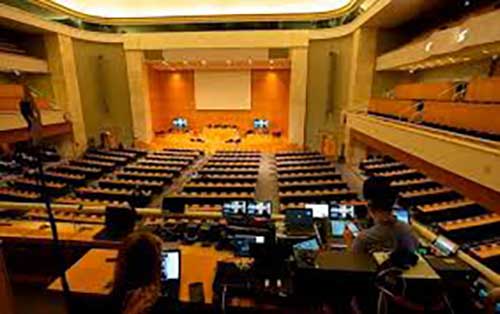
By Dr Laksiri Fernando
The 46th Session of the UN Human Rights Council started on 22 February morning with obvious hiccups. The Office, to mean the Office of the UN High Commissioner for Human Rights, finally decided to hold all sessions virtually online, only the President of the Council and the assistants in the high table sitting at the UN Assembly Hall in Geneva. The President, Ms. Nazhat Shammen Khan, Ambassador from Fiji in Geneva, wearing a saree, was graceful in the chair with empty seats surrounding.
In the opening session, the UN General Assembly President, UN General Secretary, UN High Commissioner for Human Rights, and Head of Foreign Affairs, Switzerland (as the host country), addressed remotely the session. In fact, there was no need for Switzerland to have a special place, as the UN is independent from any host country. Switzerland is fairly ok, however, if this tradition is followed, the UN General Assembly may have to give a special place to the US in New York.
Initial Addresses
UN General Secretary, Antonio Guterres’ address could have been quite exemplary if he gave a proper balance to the developed and developing countries. He talked about racism and fight against racism but did not mention where racism is overwhelmingly rampant (US and Europe) and what to do about it. Outlining the human rights implications of Covid-19 pandemic, he made quite a good analysis. It was nice for him to say, ‘human rights are our blood line (equality), our lifeline (for peace) and our frontline (to fight against violations).’ However, in the fight against violations, he apparently forgot about the ‘blood line’ or the ‘lifeline’ quite necessary not to aggravate situations through partiality and bias. He never talked about the importance of human rights education or promoting human rights awareness in all countries.
His final assault was on Myanmar. Although he did not call ‘genocide,’ he denounced the treatment of Rohingyas as ethnic cleansing without mentioning any terrorist group/s within. His call for the release of Aung San Suu Kyi and other civilian leaders undoubtedly should be a common call of all. However, he did not leave any opening for a dialogue with the military leaders or bring back a dialogue between Aung San and Min Aung, the military leader. With a proper mediation, it is not impossible. Calling for a complete overhaul as the young demonstrators idealistically claim might not be realistic.
 High Commissioner Michelle Bachelet’s address was brief and uncontroversial this time without mentioning any country or region. It is clear by now perhaps she is not the real author of the Report against Sri Lanka, but someone probably hired by the so-called core-group led by Britain. Her major points were related to the coronavirus pandemic trying to highlight some of the socio-economic disparities and imbalances of policy making that have emerged as a result. The neglect of women, minorities, and the marginalized sections of society were emphasized. But the poor was not mentioned. As a former medical doctor, she also opted to highlight some of the medical issues underpinning the crisis.
High Commissioner Michelle Bachelet’s address was brief and uncontroversial this time without mentioning any country or region. It is clear by now perhaps she is not the real author of the Report against Sri Lanka, but someone probably hired by the so-called core-group led by Britain. Her major points were related to the coronavirus pandemic trying to highlight some of the socio-economic disparities and imbalances of policy making that have emerged as a result. The neglect of women, minorities, and the marginalized sections of society were emphasized. But the poor was not mentioned. As a former medical doctor, she also opted to highlight some of the medical issues underpinning the crisis.
Then came the statements from different countries in the first meeting in the following order: Uzbekistan, Colombia, Lithuania, Afghanistan, Poland, Venezuela, Finland, Fiji, Moldova, Georgia, Kazakhstan, Equatorial Guinea, Vietnam, Belgium, and Morocco. The obvious purposes of these statements were different. Some countries were apparently canvassing for getting into the Human Rights Council at the next turn perhaps for the purpose of prestige. Some others were playing regional politics against their perceived enemies. This was very clear when Lithuania and Poland started attacking Russia.
But there were very sincere human rights presentations as well. One was the statement by the President of Afghanistan, Mohammad Ashraf Ghani. He outlined the devastating effects that Afghanistan had to undergo during the last 40 years, because of foreign interferences. The initial support to Taliban by big powers was hinted. His kind appeal was to the UN was to go ‘beyond discourse to practice’ giving equal chance to the poor and the developing countries to involve without discrimination.
Controversial Presentations
China’s Foreign Affairs Minister, Wang Yi, made his presentation almost at the end of the first day. This is apparently the first time that China had directly addressed the Human Rights Council. Beginning with outlining the devastating repercussions of the coronavirus pandemic he stressed that the world should face the challenges through ‘solidarity and cooperation.’ He broadened the concept to human rights solidarity and cooperation. His expressed views were quite different to the others, particularly to the Western ones.
He frankly said that what he expresses are the views of China on human rights without claiming those are absolute truths or forcing others to believe or implement them. There were four main concepts that he put forward before the member countries. First, he said, “We should embrace a human rights philosophy that centres on the people. The people’s interests are where the human rights cause starts and ends.” Second, he said, “we should uphold both universality and particularity of human rights. Peace, development, equity, justice, democracy, and freedom are common values shared by all humanity and recognized by all countries.” “On the other hand,” he said, “countries must promote and protect human rights in light of their national realities and the needs of their people.”
“Third,” he said, “we should systemically advance all aspects of human rights. Human rights are an all-encompassing concept. They include civil and political rights as well as economic, social, and cultural rights.” He then emphasized, “Among them, the rights to subsistence and development are the basic human rights of paramount importance.” Fourth, “we should continue to promote international dialogue and cooperation on human rights. Global human rights governance should be advanced through consultation among all countries.”
It was on the same first day before China, that the United Kingdom launched its barrage against several countries not sparing Sri Lanka. The Foreign Secretary, Dominic Raab, delivered the statement from top to bottom attacking alleged violating countries on human rights. But there was no mentioning of Israel for the repression of Palestinians or the systemic racism rampaging in the United States, including the 6 January attacks on the Capitol by extremist/terrorist groups.
His first sermon was on Myanmar without acknowledging the British atrocities or mismanagement of this poor and diverse country during the colonial period. He was quite jubilant over implementing sanctions and other restrictions over the country. Many sanctions, in my opinion, are extortions. Undoubtedly, Aung San Suu Kyi and other leaders should be released, and democracy restored. This is a task of the whole council and when one or two countries try to grab the credit, there can be obvious reservations of others.
His further scathing attacks were against Belarus, Russia, and China. Some appeared factually correct but not necessarily the approach or the motives genuine. The following is the way he came around Sri Lanka. He said,
“Finally, we will continue to lead action in this Council: on Syria, as we do at each session; on South Sudan; and on Sri Lanka, where we will present a new resolution to maintain the focus on reconciliation and on accountability.”
‘Action’ to him basically means repeatedly passing resolutions, of course imposing economic and other sanctions. He said, “as we do at each session”; like bullying poor or weak countries at each session. Can there be a resolution against Russia or China? I doubt it.
What would be the purpose of presenting a resolution against Sri Lanka? As he said, “to maintain the focus on reconciliation and on accountability.” This will satisfy neither the Tamil militants nor the Sinhalese masses. But it might satisfy the crafty Opposition (proxy of the defeated last government). This is not going to be based on any of the actual measures that Sri Lanka has taken or not taken on reconciliation or accountability. But based on the ‘Authoritarian and Hypocritical Report’ that some anti-Sri Lankans have drafted within the Office of the High Commissioner for Human Rights. This what I have discussed in my last article.
In this context, successful or not, the statement made by the Sri Lanka’s Minister of External Affairs, Dinesh Gunawardena, in rejecting any resolution based on the foxy Report of the Office of the UN High Commissioner for Human Rights, in my concerned opinion, is absolutely correct.
Opinion
President’s energy directives ignored by the Power Ministry: Another Point of View
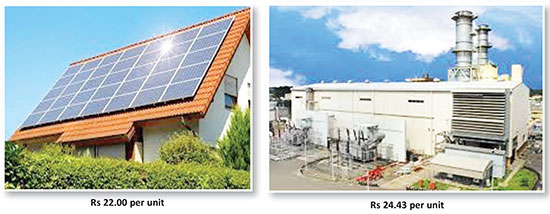
Dr Tilak Siyambalapitiya
Dr Janaka Rathnasiri laments (The Island 19 Feb 2021) that the Power Ministry has ignored the President’s directive to draw 70% of energy from renewable sources by 2030. I saw the approved costs of electricity production for 2019, published by the Public Utilities Commission (PUCSL).
PUCSL has also approved the prices to sell electricity to customers. Although various customers pay at various “approved” prices, the average income from such “approved” prices in 2019 was Rs 17.02 per unit. It is not only the Ministry, according to Dr Rathnasiri, ignoring the President; PUCSL is also breaking the law, which says prices and approved costs should be equal.
 So there is already an illegal gap of Rs 21.59 minus 17.02 = Rs 4.57 per unit of electricity sold. If electricity prices are not to be increased, as stated by many in the government and PUCSL, let us say the following: Distribution costs should decrease by 0.57 Rs per unit. Generation costs should decrease by Rs 4.00 per unit.
So there is already an illegal gap of Rs 21.59 minus 17.02 = Rs 4.57 per unit of electricity sold. If electricity prices are not to be increased, as stated by many in the government and PUCSL, let us say the following: Distribution costs should decrease by 0.57 Rs per unit. Generation costs should decrease by Rs 4.00 per unit.
PUCSL also published the approved cost of purchasing or producing electricity from various sources for 2019. The actual energy values were different to what was approved, but let us stick to PUCSL approved figures:
I suggest Dr Rathnasiri fills-up the following table, to show how much electricity will cost in 2030 to produce and deliver, if the President’s 70% target is to be achieved and for PUCSL to abide by the law. Let us assume that electricity requirement in 2030 will be double that of 2019.
 Since PUCSL has to save Rs 4 from 13.92, the average selling price for energy should be Rs 13.92 minus 4.00 = Rs 9.92. With a target network loss of 7% (in 2019 it was 8.4%), the average cost of production has to be Rs 9.27 per unit. Eight cages have to be filled-up by Dr Rathnasiri.
Since PUCSL has to save Rs 4 from 13.92, the average selling price for energy should be Rs 13.92 minus 4.00 = Rs 9.92. With a target network loss of 7% (in 2019 it was 8.4%), the average cost of production has to be Rs 9.27 per unit. Eight cages have to be filled-up by Dr Rathnasiri.
In 2012, PUCSL approved the energy cost of electricity produced from coal power to be 6.33 Rs per kWh. In 2019, PUCSL approved 9.89 (56% increase). For renewable energy, it was 13.69 in 2012, and 19.24 in 2019 (a 40% increase, but double the price of electricity from coal fired generation). In 2012, rooftop solar was not paid for: only give and take, but now paid Rs 22, against Rs 9.89 from coal. There seems to be something wrong. The price reductions of renewable energy being promised, being insulated from rupee depreciation, are not happening? Either Sri Lanka must be paying too little for coal, or it may be renewable energy is severely over-priced?
On coal we hear only of some corruption every now and then; so Sri Lanka cannot be paying less than it costs, for coal.
Enough money even to donate
vaccines
 Another reason for the Ministry of Power to ignore the President’s directive may be the Ministry’s previous experience with similar Presidential directives. In 2015, the President at that time cancelled the Sampur coal-fired power plant, and the Ministry faithfully obliged. That President and that Prime Minister then played ball games with more power plants until they were thrown out of power, leaving a two-billion-dollar deficit (still increasing) in the power sector. Not a single power plant of any description was built.
Another reason for the Ministry of Power to ignore the President’s directive may be the Ministry’s previous experience with similar Presidential directives. In 2015, the President at that time cancelled the Sampur coal-fired power plant, and the Ministry faithfully obliged. That President and that Prime Minister then played ball games with more power plants until they were thrown out of power, leaving a two-billion-dollar deficit (still increasing) in the power sector. Not a single power plant of any description was built.
Where is this deficit? You do not have to look far. In the second table, replace 24.43 with 9.89, to reflect what would have happened if Sampur was allowed to be built. The value 12.79 will go down to 8.55, well below the target of Rs 9.27 per unit to produce. Not only would CEB and LECO report profits, but the government too could have asked for an overdraft from CEB to tide over any cash shortfalls in the treasury. All this with no increase in customer prices. Producers of electricity from renewable energy could enjoy the price of 19.24 Rs per unit. And that blooming thing on your rooftop can continue to enjoy Rs 22 per unit. The Minister of Power, whom Dr Rathnasiri wants to replace with an army officer, would have been the happiest.
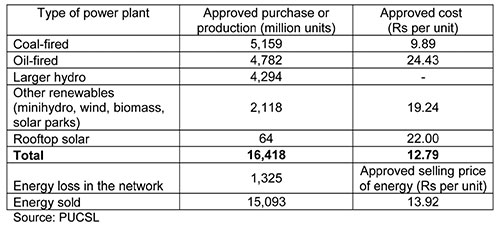 In the absence of Sampur (PUCSL’s letter signed by Chairman Saliya Mathew confirmed cancellation and asked CEB not to build it), PUCSL approved electricity to be produced at Rs 21.59 and sold at Rs 17.02 per unit. The annual loss would be Rs (21.59 – 17.02) x 15,093 = Rs 69 billion per year of approved financial loss. Sri Lanka has a Telecom regulator, an Insurance regulator, a Banking regulator, who never approve prices below costs. Sometime ago the telecom regulator asked the operators to raise the prices, when operators were proposing to reduce prices amidst a price war. But the electricity industry regulator is different: he approves costs amounting to 27% more than the price, not just once but, but continuously for ten long years !
In the absence of Sampur (PUCSL’s letter signed by Chairman Saliya Mathew confirmed cancellation and asked CEB not to build it), PUCSL approved electricity to be produced at Rs 21.59 and sold at Rs 17.02 per unit. The annual loss would be Rs (21.59 – 17.02) x 15,093 = Rs 69 billion per year of approved financial loss. Sri Lanka has a Telecom regulator, an Insurance regulator, a Banking regulator, who never approve prices below costs. Sometime ago the telecom regulator asked the operators to raise the prices, when operators were proposing to reduce prices amidst a price war. But the electricity industry regulator is different: he approves costs amounting to 27% more than the price, not just once but, but continuously for ten long years !
That is 370 million dollars per year as of 2019, the economy is spending, and for years to come, to burn oil (and say we have saved the environment). Did the Minister of Health say we are short of 160 million dollars to buy 40 million doses of the vaccine? Well, being a former Minister of Power, she now knows which Presidential “order” of 2015 is bleeding the economy of 370 million dollars per year, adequate to buy all vaccines and donate an equal amount to a needy country.
Prices are the production costs approved by PUCSL for 2019. The selling price approved by the same PUCSL was Rs 9.27 per unit.
Opinion
Confusion on NGOs and NSOs in Sri Lanka
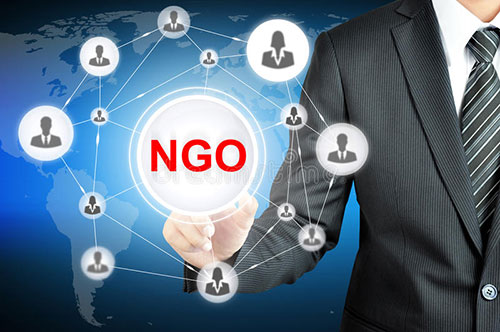
If you listen to politicians and journalists here, you will hear of that curious creature rajya novana sanvidane, a Non-State Organization (NSO). Where do you get them? In the uninstructed and dead minds of those who use those terms. In the real world, where politicians and journalists have developed minds, there are Non-Governmental Organizations (NGO). The United Nations is an organization set up by state parties, not by governments. It is true that agents of states, governments, make the United Nations work or fail. Governments may change but not the states, except rarely. When Eritrea broke away from Ethiopia, a new state was formed and was so recognised by the United Nations. However, the LTTE that tried to set up another state was crushed by the established state that it tried to break away from, and the UN had nothing to do with them.
This entirely unnecessary confusion, created out of ignorance, is so destructive that organizations completely loyal to the existing state, are made to be traitorous outfits, for they are ‘non-state organizations’ within the state. There are citizens of each state, but no citizens of any government. Government is but an instrument of the state. In most states there are organizations, neither of the state nor of government: religious organizations including churches. But none of them is beyond the pale of the state.
Those that speak of rajya novana sanvidane give that name partly because they have no idea of the origin of non-governmental organizations. NGOs came into the limelight, as donor agencies, noticed that some governments, in East Africa, in particular, did not have the capacity and the integrity to use the resources that they provided. They construed, about 1970, that NGOs would be a solution to the problem. Little did they realize that some NGOs themselves would become dens of thieves and brigands. I have not seen any evaluation of the performance of NGOs in any country. There was an incomplete essay written by Dr. Susantha Gunatilleka. NGOs are alternatives to the government, not to the state.
Our Constitution emphatically draws a distinction between the government and state, and lays down that the President is both Head of Government and Head of State (Read Article 2 and Article 30 of the Constitution.) It is as head of state that, he/she is the Commander of the Armed Forces, appoints and receives ambassadors and addresses Parliament annually, when a prorogued Parliament, reconvenes. He/she presides over the Cabinet as head of government. The distinction is most clear, in practice, in Britain where Queen Elizabeth is the head of state and Boris Johnson is the Prime Minister and head of government. However, in principle, Johnson is the Queen’s First Minister appointed by the sovereign, and resigns by advising her of his decision to do so.
In the US and in India the term ‘state’ has special significance. In India there is a ‘rajya sabha’ (the Council of States) whose members represent constituent States and Union Territories. Pretty much the same is true of the United States. In the US, executive power is vested in the President and heads the administration, government in our parlance. The Head of State does not come into the Constitution but those functions that one associates with a head of state are in the US performed by the President of the Republic. The US President does not speak of my state (mage rajaya) but of my administration, (mage anduva). Annually, he addresses Congress on the State of the Union. Our present President must be entirely familiar with all this, having lived there as a citizen of the US for over a decade. It is baffling when someone speaks of a past state as a traitor to that same state. It is probable that a government was a traitor to the state. ‘Treason against the United States, shall consist only in levying war against them, or in adhering to their (States’) enemies, giving them aid and comfort’. That a state was a traitor to the same state is gobbledygook.
Apart from probable confusion that we spoke of in the previous paragraph, it is probable that a president and other members of a government, including members of the governing party here, find it grandiloquent to speak of his/her/their state (mage/ape rajaya), rather than my government (mage anduva) or Sirisena anduva’ and not Sirisena state; it was common to talk of ‘ape anduva’ in 1956; politicians in 1956 were far more literate then than they are now.
When translating from another language, make sure that you understand a bit of the history of the concept that you translate. A public school in the US is not the same as a public school in the UK.
MAHADENAMUTTA









